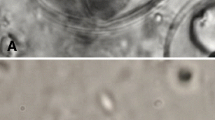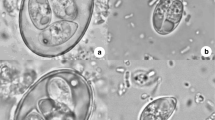Abstract
The Guelph strain of Eimeria adenoeides was obtained from a commercial turkey flock in Ontario, Canada, in 1985. Single oocyst derived lines of E. adenoeides were propagated, and one of them used to re-describe biological and morphological features of E. adenoeides in the turkey. Oocysts of this strain are within the lower size ranges in the original species description reported by Moore and Brown (1951); oocysts of the Guelph strain averaged 18.7 ± 1.4 μm (16.7-22.5) by 14.3 ± 0.9 μm (13–16.2, n = 30) with a shape index (SI) of 1.3 ± 0.1. It is possible that the original species description was based, at least in part, on a mixed culture of two or more Eimeria species. Immature first-generation meronts of E. adenoeides Guelph strain were observed histologically at 32 h post-infection in the ileum and cecal neck. Early studies reported only two asexual generations suggested that first asexual cycle observed at 32 h post-infection was overlooked. In the present study, three asexual generations were observed before the start of gametogony. The Guelph strain is also characterized by a prepatent period of 112 h. The Guelph strain of E. adenoeides is a highly pathogenic coccidium that forms classic cecal lesions, including prominent caseous cecal cores, during moderate to severe infections. The maximum output of oocysts (1.77 × 107 per bird) was obtained from birds inoculated with 1 × 103 oocysts; maximum fecundity (1.55 × 105 oocyst shed per oocyst inoculated) was obtained with an inoculation of 1 × 102 oocysts, but fecundity dropped dramatically as the inoculation dose increased. To promote stability of the E. adenoeides species concept, neotype specimens (a parahapantotype slides series and phototype) have been designated and deposited for future reference.






Similar content being viewed by others
References
Bemrick WJ, Hammer RF (1978) Scanning electron microscopy of damage to the cecal mucosae of chickens infected with Eimeria tenella. Avian Dis 22:86–94
Chapman HD, Muthavarapu VK, Matsler PL, Chapman ME (2005a) Acquisition of immunity to Eimeria maxima in newly hatched chickens given 100 oocysts. Avian Dis 49:426–429
Chapman HD, Roberts B, Shirley MW, Williams RB (2005b) Guidelines for evaluating the efficacy and safety of live anticoccidial vaccines and obtaining approval for their use in chickens and turkeys. Avian Pathol 34:279–290
Chapman HD (2008) Coccidiosis in the turkey. Avian Pathol 37:205–223
Clarkson MJ (1956) Experimental infection of turkey poults with Eimeria adenoeides (Moore and Brown, 1951) isolated from a natural case in Great Britain. Nature 178:196–197
Clarkson MJ (1958) Life history and pathogenicity of Eimeria adenoeides Moore and Brown, 1951, in the turkey poult. Parasitology 48:70–88
Clarkson MJ, Gentles MA (1958) Coccidiosis in turkeys. Vet Rec 70:211–214
El-Sherry S, Ogedengbe ME, Hafeez MA, Barta JR (2013) Divergent nuclear 18S rDNA paralogs in a turkey coccidium, Eimeria meleagrimitis, complicate molecular systematics and identification. Int J Parasitol 43:679–685
El-Sherry S, Ogedengbe ME, Hafeez MA, Sayf-Al-Din M, Gad N, Barta JR (2014). Sequence-based genotyping clarifies conflicting historical morphometric and biological data for five Eimeria species infecting turkeys. Poult Sci, in press.
Hawkins PA (1952) Coccidiosis in turkey. Technical bulletin 226, East Lansing, MI: Michigan State College Agricultural Experimental Station
Hein H (1969) Eimeria adenoeides and Eimeria meleagrimitis: pathogenic effect in turkey poults. Exp Parasitol 24:163–170
Joyner LP (1973) Coccidiosis in turkeys and its control. Folia Vet 3:110–123
Long PL, Millard BJ, Shirley MW (1977) Strain variation within Eimeria meleagrimitis from the turkey. Parasitology 75:177–182
Lund EE, Farr MM (1965) Coccidiosis of the turkey. In: Biester HE, Schwarte LH (eds) Diseases of poultry, 5th edn. Iowa State University Press, Ames, pp 1088–1093
Madden PA, Ruff MD (1979) Eimeria dispersa, E. adenoeides, and E. meleagrimitis: intestinal mucosal disruption in turkeys as seen with scanning electron microscopy. J Parasitol 65:234–242
Matsler PL, Chapman HD (2006) Characterization of a strain of Eimeria meleagridis from the turkey. Avian Dis 50:599–604
Moore EN, Brown JA (1951) A new coccidium pathogenic for turkeys, Eimeria adenoeides n. sp. (Protozoa: Eimeriidae). Cornell Vet 41:124–135
Moore EN, Brown JA (1952) A new Coccidium of turkeys, Eimeria innocua n. sp. (Protozoa: Eimeriidae). Cornell Vet 42:395–402
Poplstein M, Vrba V (2011) Description of the two strains of turkey coccidia Eimeria adenoeides with remarkable morphological variability. Parasitology 138:1211–1216
Price KR, Guerin MT, Newman L, Hargis BM, Barta JR (2013) Examination of a novel practical poultry management method to enhance the effect of live Eimeria vaccination for conventionally housed replacement layer pullets. Int J Poult Sci 12:175–184
Reid WM (1972) Turkey. In: Hofstad MS, Calnek BW, Helmboldt CF, Reid WM, Yoder HW (eds) Diseases of poultry, 6th edn. Iowa State Press, Ames, pp 977–986
Remmler O, McGregor JK (1964) A method to facilitate isolation of single coccidial oocysts. J Parasitol 50:294
Ruff MD, Witlock DR, Smith RR (1976) Eimeria acervulina and E. tenella: effect on methionine absorption by the avian intestine. Exp Parasitol 39:244–251
Shirley MW (1995) Eimeria species and strains of chickens. In: Biotechnology guidelines on techniques in coccidiosis research, Luxembourg, European Commission, pp 1–24
Tyzzer EE (1929) Coccidiosis in gallinaceous birds. Am J Hyg 10:269–383
Tyzzer EE, Theiler H, Jones EE (1932) Coccidiosis in gallinaceous birds. II. A comparative study of species of Eimeria of the chicken. Am J Hyg 15:319–393
Williams RB (2001) Quantification of the crowding effect during infections with the seven Eimeria species of the domesticated fowl: its importance for experimental designs and the production of oocyst stocks. Int J Parasitol 31:1056–1069
Acknowledgments
This work was supported by grants from the Natural Sciences and Engineering Research Council of Canada (NSERC), the Ontario Ministry of Agriculture, Food and Rural Affairs (OMAFRA), and from the Federal Economic Development Agency for Southern Ontario (FedDev) to J.R.B. and scholarship support from the Ministry of Higher Education and Research (MOHE), Egypt, to S.E.S. administered through the Bureau of Cultural and Educational Affairs (BCEA) of Egypt in Canada. Scholarship support by the Ontario Veterinary College (OVC PhD Scholarship) to M.E.O. is gratefully acknowledged. Julie Cobean and Julia Whale are thanked for their skilled technical assistance. The staff of the CAF Animal Isolation Facility at the University of Guelph is thanked for their skilled care of experimental animals used in this study.
Author information
Authors and Affiliations
Corresponding author
Rights and permissions
About this article
Cite this article
El-Sherry, S., Ogedengbe, M.E., Hafeez, M.A. et al. Re-description of a genetically typed, single oocyst line of the turkey coccidium, Eimeria adenoeides Moore and Brown, 1951. Parasitol Res 113, 3993–4004 (2014). https://doi.org/10.1007/s00436-014-4066-7
Received:
Accepted:
Published:
Issue Date:
DOI: https://doi.org/10.1007/s00436-014-4066-7




